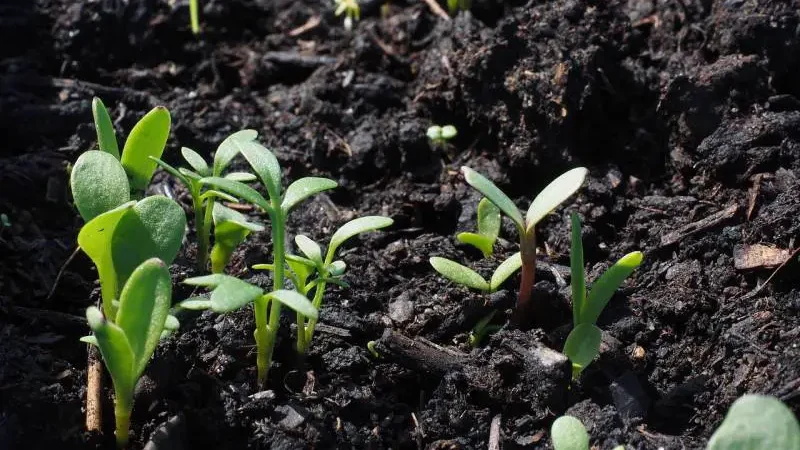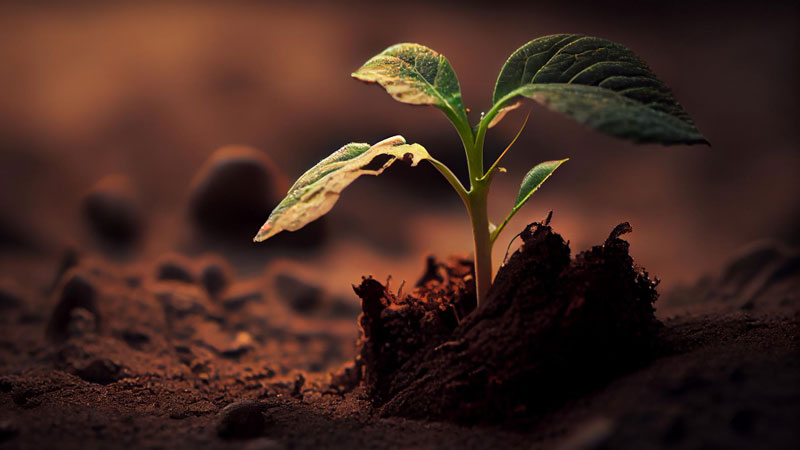Why Are My Seedlings Growing So Slow? [9 Causes With Solutions]

If you are wondering why your seedlings are growing so slow, thin, and pale, it’s a visible sign that they are struggling and need immediate attention. Seeds germinate to form seedlings and later into flourishing plants growing.
Strong and healthy seedlings guarantee effective plant growth.
However, several reasons can make a seedling grow slowly and weak. As a farmer or plantsman, you should be able to tell all the challenging factors that make particular seedlings grow slowly while others stall and die unexpectedly.
This article will look at eight common problems that make seedlings mature slowly.
1. Lack of Essential Nutrients
Most seedlings stall a few days or even a few weeks after germinating because they lack enough nutrients in their structure. Altered amounts of nutrients in fertilizers enable seedlings to make their food and grow strong.
Seedlings should be given enough nitrogen if it has suddenly stopped growing or if their growth is slow. Plant root problems like insufficient oxygen could also cause seedlings that mature slowly. Maturing roots need phosphorous, sulfur, and other essential nutrients to grow fast.
Enough phosphorous nutrients in the soil facilitate the seedling’s growth. Nitrogen is a major component of chlorophyll. Also, when you notice the young leaves turning either yellow or pale green, it clearly indicates that the seedlings are dying slowly and need immediate attention.
Fertile soils that facilitate efficient seedling growth should contain medium levels of Nitrogen (N), Potassium (K), Phosphorous (P), Calcium (Ca), Sulphur (S), and Magnesium (Mg).
2. Poor Soil Structure
If your seedlings are growing so slow, remember that soil structure plays a significant role in determining root growth. Good soil should drain well and contain loose particles that allow the roots to breathe. Also, it should contain organic matter. When your seedlings grow slowly, it’s either the soil structure that does not dry sufficiently or crumbly.
Though seedlings grow well in loosely packed soils, it does not mean seedlings planted in clay soil will grow slower than those planted in loam soil. The significant difference is the plant species you have in the garden.
For example, some seedlings do well in loam, while others do well in sand or clay soil.
3. Hot Compost
If you are using compost to plant your seedlings, you must ensure that the compost is cool enough to facilitate seedling growth. Composts are usually hot because millions of microorganisms break down the organic matter. A compost pile should be allowed enough time to cool before planting any seeds.
Otherwise, if you plant your seeds in hot compost, they will not only take time to germinate, but the seedlings will need more time to reach their optimum height.
A good compost that can facilitate fast seedling growth should include different amounts of:
- vegetable peelings
- fruit waste
- cardboard egg boxes
- plant pruning and
- grass cuttings
4. Lack Of Water
Water, just like nutrients, is another essential ingredient that facilitates faster plant growth. Maturing seedlings need water just like they need enough sunlight. Water is essential because it assists the seedlings in transporting all the critical nutrients, like sugar, from the roots through the stem to the leaves. Without enough water, seedling cells become dry and damaged – and when the cells are damaged, the seedling will mature slowly.
You should water your seedlings frequently or daily if possible (BUT DO NOT OVERWATER THEM). The soil should only dry partially before you water the seedlings again.
Overwatering your seedlings is much worse than underwatering them because overwatering causes the roots of your seedlings to rot. And when it rots, it can’t perform as it’s supposed to, absorbing the nutrients it needs to grow. You might be too excited to let it grow overnight, but growing seedlings take time and at its own pace.
So when watering them, ensure that you don’t make them too wet. Just enough to keep its soil moist and most of all, you must also allow its soil to drain.
5. Aphids And Insect Attack
Aphids and other harmful insect larvae are common enemies to seedlings and young plants and even to mature plants. When aphids attack a seedling, its growth is suffocated, and its maturity rate tends to be slow. Neglecting your seedlings when you notice aphid and insect attacks can lead to seedling damage.
How do aphids attack plants and seedlings?
These stubborn, small sap-sucking insects severely damage plants and seedlings by sucking water and juice from the plants’ structure. A seedling attacked by the aphids will grow slower than the rest. In the worst-case scenario, most seedlings die around the first few weeks if the aphids have rigorously attacked them.

6. Fungal Infection
Different types of fungus and fungal infections can choke plants’ growth. Seedlings are delicate growing and face a high risk of fungal infection than mature plants. Root fungus, for this instance, can cause slow growth in most seedlings.
Other types of fungal infections cause yellowing of leaves and branch damage. Depending on the specific seedlings you intend to grow, you should identify the fungus that threatens your seedlings.
Here are a few common fungi and fungus infections that cause damage to seedlings.
- Black spot – This fungus affects the rose flower leaves and reduces plant vigor.
- Powdery mildew – A common fungus that affects most plants.
Powdery mildew causes mature plants to weaken and young seedlings to die/struggle to grow. - Blight – Blight disease commonly affects tomatoes and potatoes.
A seedling affected by blight will mature slowly and struggle throughout its life. - Wilt – A wilted seedling looks drooped and non-rigid.
Wilting can be caused by under-watering your seedlings or fungal infection. - Rust – Rust is another common problem that damages most seedlings.
Rust can cause stalled growth in both seedlings and mature plants. - Clubroot – This fungal infection commonly attacks broccoli, Brussels sprouts, cauliflower, cabbages, radishes, stocks, turnips, wallflowers, and other plants of the family Brassicaceae (Cruciferae).
To notice clubroot in seedlings is quite challenging. However, if the clubroot attacks your seedlings, they will grow slowly and can even die prematurely. - Anthracnose – This fungal infection attacks seedling and young plants during the cool and wet season.
Infected seedlings will grow slowly, and you will notice dark, water-soaked lesions on the leaves or stem.
Remedy: To kill fungus and cure the fungal infection, apply the recommended amounts of baking soda (Sodium bicarbonate) or spray fungicide to your seedlings early.
7. Competition From Other Seedlings
Seedlings will compete against their own or against other species to survive; that’s why your seedlings could be growing so slow. This is natural. Once you notice specific seedling(s) growing slower than the rest, it could be because of competition from the other seedlings.
Competition mostly happens when seedlings are planted in the same seedbed. Farmers do not plant seedlings separately, as this is the case nowadays. So, when these seedlings mature, some will be deprived of the necessary nutrients and tend to mature slowly.
You should ensure that all seedlings are planted separately and monitor them equally. Also, it would be best if you understood that specific seedlings do not mature at the same rate. Each seed has its individual needs.
When you plant your seedlings together, some will mature faster than others.
Transplanting Your Seedlings When You Notice Competition Is Getting Stiff
You shouldn’t pluck your seedlings and plant them elsewhere on the farm. Transplanting seedlings is a delicate and slow process that needs keen eyes.
Here are six steps to carry out a successful seed transplant:
- Know the appropriate time to transplant your seedlings.
- Dig the appropriate hole which can fit your seedlings plus their roots
- Remove the seedling from its original/previous home.
- Place the seedling into the hole.
- Fill the hole with nutrient-rich soil.
- Add enough water after the transplant is complete (do not add excess water that washes away the nutrients).
- Allow the seedlings to grow naturally in their new home.
8. Lack Of Enough Light
Light is among the most critical factors why your seedlings are growing so slow. A seedling that is deprived of light will not only grow slowly but will be leggy. Photosynthesis, on the other hand, is the process by which plants convert light energy to chemical energy and energy-rich organic compounds.
It occurs when the plant gets enough light energy and water. Plants need warmth and sufficient light to photosynthesize efficiently, and the soil must be warm enough to facilitate faster and safer seedling growth. If your seedlings are growing slowly, you must also check whether the light source is enough.
As a farmer planting seedlings indoors, you should use an alternative artificial lighting source to ensure the seedlings get enough light. The appropriate soil warmth is about 65°F (18°C) to 75°F (24°C).
9. Change of Environment After Transplant
Like all things, getting used to a new environment, your seedlings might undergo many changes after transferring from an indoor nursery to an outdoor garden. And this happens when you are not being careful during the process.
When your seedlings cannot properly adapt to their new environment, they might stunt their growth.
So what should you do?
You can keep this from happening by allowing your seedling to adapt to its new environment before transplanting it there. This means you must expose it to the elements, such as temperature, rain, sunlight, and wind.
Final Thought
Neglecting your seedlings is another cause of slow growth. By neglecting your seedlings, they will lack all the necessary ingredients needed for efficient growth. When you start noticing inferior plants/weeds in the same pot as your seedlings, you should remove them immediately.
Weeds and unwanted plants drain nutrients from the soil and leave your seedlings suffocating and dry. If you plan on having your seedlings planted in a tightly compacted space, the above eight points discussed should give you an insight into understanding how to precisely take care of your seedlings.
Note: Do not plant different seedling species together in the same bed.